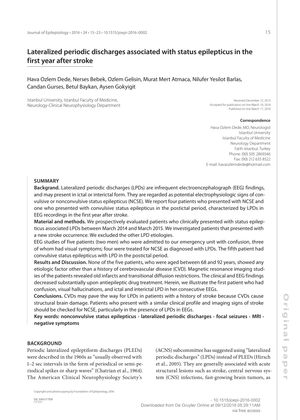Secondary Syphilis in Patients Treated at the City Institute for Skin and Venereal Diseases in Belgrade from 2010 to 2014
June 2015
in “
Serbian Journal of Dermatology and Venereology
”

TLDR The conclusion is that cerebrovascular diseases can cause seizure-like activity in stroke patients, which can be improved with antiepileptic drugs.
Between March 2014 and March 2015, a study of 436 emergency EEG exams identified lateralized periodic discharges (LPDs) in 5 patients aged 68 to 92 with a history of cerebrovascular disease (CVD) and previous strokes. These patients showed clinical and EEG improvement following antiepileptic drug treatment. The study suggests that CVDs can lead to LPDs in stroke patients and recommends evaluating such patients for nonconvulsive status epilepticus (NCSE) when LPDs are observed. LPDs were associated with focal seizure symptoms or neurologic signs, and while intravenous benzodiazepine therapy could resolve focal seizure activity, it did not always eliminate LPD activity. However, antiepileptic drugs were effective in resolving LPD activity in four patients. The study emphasizes the importance of EEG evaluation in patients with fluctuating symptoms, as NCSE can mimic stroke episodes, and LPDs may indicate both interictal and ictal activity. No conflicts of interest were declared.